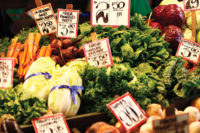Confusion over Local, Organic
Even with the sharp increase in popularity of local and organic foods, nearly one in five consumers confuse the two terms.

A recently published UF study, in partnership with three other research universities, looks to help sellers and producers of local and organic products to market their messages better, by either reinforcing awareness or dispelling consumer misconceptions. After spending millions of dollars promoting brand awareness, the organic-food industry found that many consumers confuse “organic” food with “local” food products, said economist Ben Campbell of the University of Connecticut, the study’s lead author.
Hayk Khachatryan, a UF assistant professor for food and resource economics, collaborated with Campbell and other scientists in a 2011 online survey of 2,511 people in the U.S., learning that 17% believed the terms were interchangeable.
“If consumers can distinguish between local and organic, then by buying organic, they will be able to reduce their exposure to synthetic pesticides,” said Khachatryan, who works with the Mid-Florida Research and Education Center in Apopka, under the guidance of the Institute of Food and Agricultural Sciences. “However, there is no guarantee that organic is grown locally. Before reaching the consumer, organic produce may travel long distances, which involves some level of environmental footprint.”
For the same reason, he added, locally produced food may not be a sustainable choice, when better quality produce is grown and transported less expensively from outside the area.
Among the other findings, 22% of respondents mistakenly thought “local” refers to non-genetically modified foods. Several states are debating GMO regulation and labelling, making it crucial that consumers recognize that locally labeled produce does not equate with non-GMO foods, Campbell said.
“We are not saying GMO is bad or good, but rather that local does not imply GMO-free,” said Campbell.
Over the last decade, there has been an increasing demand for local and organic products in the U.S., where sales of organic products in 2010 reached $26.7 billion, as well as another $2.6 billion in Canada, according to figures from the Organic Trade Association, which promotes organic food producers and associated industries.
As for locally grown food, exact statistics are hard to pin down, but the U.S. Department of Agriculture estimates sales of local products were as much as $4.8 billion in the U.S. in 2008.
Another factor adding to consumer confusion is that Canada has changed the definition of “local” food; in the U.S., the definition of “local” food fluctuates by jurisdiction.
Both the U.S. and Canadian rules governing organic production must refer to, in part, products grown without synthetic pesticides. The USDA organic seal indicates that the item was produced without the use of irradiation, sewage sludge or genetically modified organisms.
Khachatryan and Campbell co-wrote the report with Charles Hall, professor and Ellison Endowed Chair in International Floriculture at Texas A&M University, Bridget Behe, a Michigan State University horticultural marketing professor; and Jennifer Dennis, associate professor of horticulture and agricultural economics at Purdue University.
The study appears in the May edition of the International Food and Agribusiness Management Review.
Looking for a reprint of this article?
From high-res PDFs to custom plaques, order your copy today!








